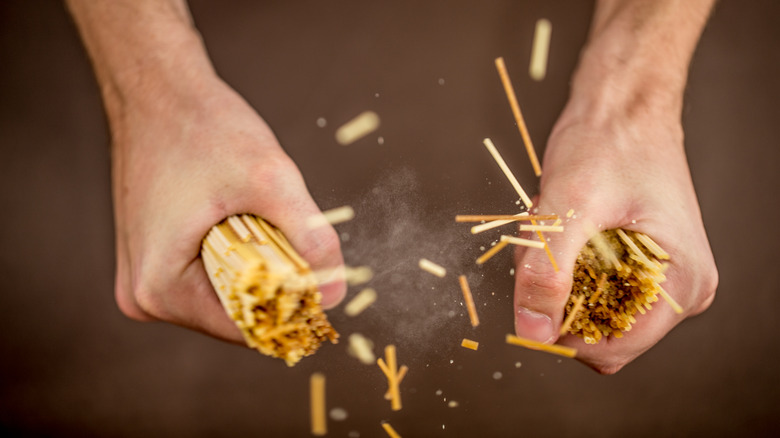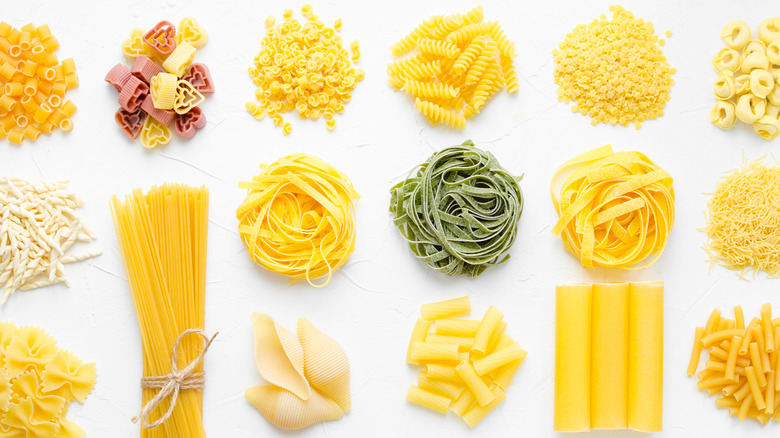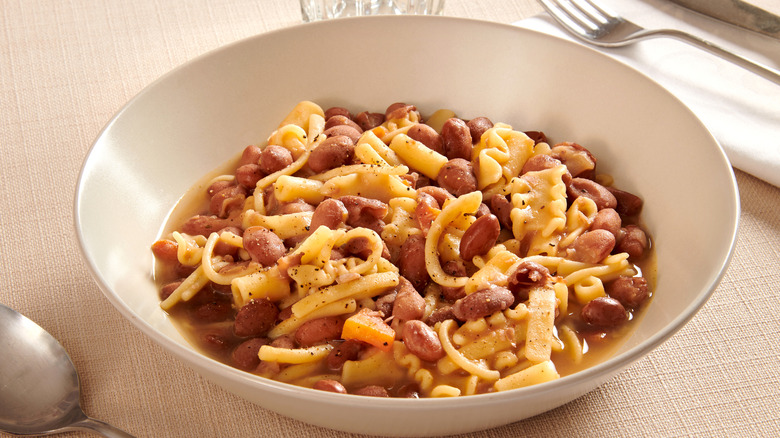You Should Think Twice Before Breaking Longer Pasta Noodles
Straightforward as it may seem, cooking pasta isn't just a matter of boiling noodles in water. In fact, the process is actually sort of complicated as there are a bunch of factors that can affect taste, texture, and overall dining pleasure. Yet, of the many rules to abide by, there's one faux pas that should never be made, and that's breaking the noodles.
For many, tradition (and even superstition) may account for why long and lengthy strands of pasta are left intact. However, the reality is breaking long pasta strands is urged against because it's totally unnecessary. Why? Well, basically, these elongated noodles are intended to be twirled by a fork.
When left in their original form, any number of long pasta, from bucatini to linguine to mafaldine can easily be wrapped into a flavorful bite. It's precisely their length (matched with the twisting technique) that allows these saucy noodles to perfectly cling onto a fork in a tight and mess-free bundle. That said, when these nearly 10-inch strands are broken into shorter noodles, they actually become more difficult to eat as they can't be twirled efficiently, nor can they be simply stabbed due to their slender shape.
Plus, breakage can also be a challenge during plating. When supported by a ladle, longer noodles drape around serving tongs better, which allows for a neater presentation. Since we eat with our eyes first, resisting the urge to break noodles proves just as important from a practical standpoint, as it does visually.
Rather than break noodles, do this instead
We totally understand that there are reasons why you might feel the need to break up bavette or snap spaghetti in pieces. For example, if you're working with a pot that's too small and noodles that are too long, you might be tempted to break the noodles in half, but the solution is simple. Either invest in a larger or oblong-shaped pot or wait a few seconds until the wet ends of the noodles have softened and they can be fully submerged. As for splitting capellini and bigoli in half to combat sticking together in the pot, a drizzle of olive oil can minimize clumping, but frequent stirring should be enough.
If, however, breaking pasta is a deliberate choice to make your dining experience more pleasurable, we suggest opting to cook shorter types of pasta. Sturdy penne, spiralized Gemelli, curved conchiglie, twisted cavatappi, or aesthetic rotelle can all be great substitutes for ribbons of pasta that prove way too long.
Of course, you could always just practice your fork-twirling skills, as well. To make the process easier, begin by stabbing a strand or two of pasta with your fork. You can also use a spoon for extra guidance, although this isn't always deemed proper pasta-eating etiquette, so it's best to limit spoon use once you've built confidence. After pasta is secured, simply flick your wrist to help wrap noodles around the tines of a fork, repeating several times until you've twisted the perfect forkful.
Noodles already broken? We've got you covered
Unfortunately, no variety of long pasta is immune to breakage. Chances are that there will probably be at least a couple of broken noodles in any package of pasta. However, there's no need to worry about a few stray pieces intermingled with longer strands. Fragments of pasta won't compromise cook time or flavor. The only risk is aesthetics, but it's likely that the odd split strand will nestle into a pasta bundle seamlessly.
In contrast, should you have a package of fettuccine that has seen better days, you can still put these broken bits to good use. Drawing from the traditions of cucina povera that saw nothing go to waste, you can use the snapped pieces in a soup that needs some bulking up. Alternatively, the pasta scraps could also be mixed with other leftover varieties in a makeshift minestrone that boasts fabulous texture — just know that this is one of the only times that you can get away with breaking pasta!
That said, it would be remiss not to address the fact that sometimes pasta is actually meant to be broken. In the case of certain varieties like ziti, before the noodles began commonly being sold pre-cut, snapping the pasta into several fragments was actually expected and encouraged given its length of about 9.8 inches when it's made. Broken into the size of your choice, ziti would then be used in baked pasta dishes. What can we say? Some rules are meant to be broken!


